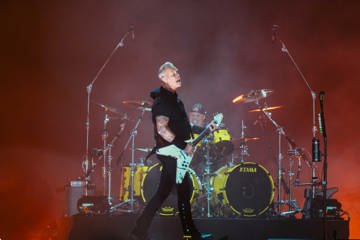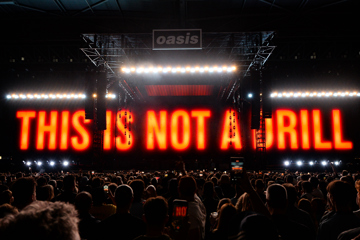Lucy Guerin Goes Back To Basics for Dance Massive Premiere 'Split'
"My work comes from a desire to understand the relationship between the narrative and the abstract."
Since founding her company 15 years ago, choreographer Lucy Guerin is today one of Australia's most established and respected dance makers. But she is also an artist whose work is defined by its seemingly limitless originality. Longevity and creative innovation are both hallmarks of great art, but this duality also poses something of a cognitive dissonance: is it possible to establish a distinctive, unmistakable voice while at the same time breaking new ground?
For Guerin, the answer to this question is a case of artistic perpetual motion. "The idea of originality and newness [as a conscious creative driver] is a bit contentious in a way, because everything we create is innately new, but of course, it is impossible to make a piece without absorbing influences from the people around you, ideas that are around you at that creative moment, but also ideas from the past," she observes. "For me, my process is referential without necessarily having to be repetitive. Generally, a previous work will have some unexplored aspect to it that compels me to delve deeper, or prompts me to react against it. That way the work is constantly refreshing itself and expressing itself through what came before."
In Guerin's creative universe, each piece is both its own self-contained world and a precursor to its successor, without being explicitly hitched to any arbitrary stylistic codex. There is, however, one persistent muse that can be found in every step of Guerin's canon: the human form. "I've always been a big believer in experimenting with movement; actually researching, in the studio, on the body," she explains. "I find it far more stimulating if ideas stem from a physical practice rather than a set of ideas or conceits that are then somehow realised through dance. The foundation of the work has to be firmly rooted in the body and in ideas that the body can express physically. There are, of course, many levels of conceptuality and thought that go along with this, but personally, I'm more inspired by doing rather than thinking."
"My work comes from a desire to understand the relationship between the narrative and the abstract."
While this approach nurtures an unrestrained freedom of expression, released from the limitations of character or narrative, working in the language of pure dance poses its own challenges. Perhaps the most problematic of these hurdles is also the most ironic. A rejection of plot in favour of a less convoluted abstract aesthetic can make the pure dance model seem aloof, or even hostile, to those uncomfortable with an absence of story. "There's a very entrenched attachment to this linear, concise understanding of a work, phonetically or narratively. It's almost as if there needs to be a link to something language-based - can this dance be articulated in speech as well as in movement?" Guerin notes.
Don't miss a beat with our FREE daily newsletter
Arguably, it's not hard to understand why contemporary dance is sometimes viewed as challenging. In a medium that celebrates the nuance and virtuosity of the human body on stage, the power and exhilaration of that work is anchored to the subjective awe of the audience, marvelling at skills beyond their own personal abilities. However, this immediately strong connection between performer and viewer, also craves a context: Who is that person? What are they doing? Where do they fit and what is their purpose? An absence of answers can be deemed unreasonably frustrating.
"For me that's not where the power of dance lies," Guerin insists, but despite this assertion, many works from her oeuvre still boast a strong sense of the theatrical. Recent examples include 2015's Motion Picture, which draws on 1950's film noir classic D.O.A. as the impetus for the choreography, and The Dark Chorus, premiered at the 2016 Melbourne Festival, which channels the brooding mysticism of an obscure ritual. It's a facet of Guerin's work that she deploys strategically: "I often feel like the anti-narrative crusader, which I'm really not — I love stories! But I feel like dance is not always the best place to articulate them, at least in a direct sense. Where storytelling can be useful is in offering some contrast. A lot of my work comes from a desire to understand the relationship between the narrative and the abstract, to sort of point out the different communicative force of, for example, dance and language."
This philosophy — using the physical to examine the intangible — has created the spine of Guerin's latest piece, Split. A pared-back duet, it is a danced exploration of time and space — "the fundamental elements of choreography and movement," in Guerin's words. In an aptly poetic sense, Split also represents a chance for the highly in-demand dance maker to reset her career clock. After an intense and "high pressure" period of working on larger scale pieces, complete with the audacious designs and technical clout expected from a top-tier artist such as Guerin, this return to simple intimacy has been a therapeutic experience.
"I really felt I needed to get back into the studio with a small number of dancers, that was the inspiration from the start. Then as we began trying things out, this very binary idea emerged — this idea of two different sides of an individual, representing the kinds of internal conflicts we all experience as thinking, feeling human beings," Guerin shares. "It's a structure that has its own trajectory — not in a narrative sense — but at the same time, it is very emotionally evocative. These two bodies are forced to negotiate each other, to either be in harmony or conflict. It really excites me when the process of choreography reveals a structure that tells its own story without it having to be enacted, so this piece has been a really happy discovery."
Lucy Guerin Inc presents Split, 16 — 19 & 23 — 26 Mar at Arts House, part of Dance Massive.







